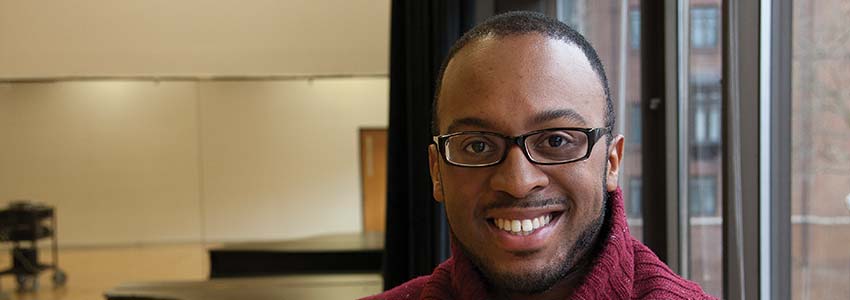“I’m exploring visibility, surveillance, and invisibility. I’m asking questions about how the moving body addresses these issues.”
Marcus’ research in dance focuses on how the human body brings to life themes related to issues of visibility, surveillance and belonging. The culmination of his master’s thesis is a dance for camera screening comprised of a collaboration between graduate students from dance, the Interarts program, undergraduate dance majors and other resources within the University community. “Using the amazing resources here at Michigan like the Duderstadt Video Studio allows me to see how technology can make the body hypervisible, and how the body is in and of itself a technology and a spectacle.”
Phase One of the Visibility Project was the creation of his solo dance work, Pearls. Described as “ingenious” and “vulnerable,” by the Chicago Tribune, this award-winning work examines the complexities of gender performance. The work has been performed at Harvest Chicago Contemporary Dance Festival, Hollins University, and most recently was the recipient of the Maggie Allesee New Choreography Award at the Michigan Dance Festival hosted at Oakland University. “I’ve been incubating this work at the University and it’s exciting to see the work expand beyond the University. My research is rooted in creating artistic processes and projects. I use texts such as the body and the written word to generate and solve problems. It is through the doing.”
Marcus took the traditional route as an undergraduate then spent some years working in his field. He came back to school to pursue a role in academia in the arts. “I want an understanding of new methods, to be engaged with other scholars and be creative within the University setting. There are thinkers, doers, people engaged in this work here.”
Acknowledging some of the challenges of graduate school, he says, “I focused on my work within the department and less on integrating within the University community.” In his second year, he has made a concerted effort to get involved. He has participated in Rackham’s Arts of Citizenship program, aligned with civic and humanities groups on campus, and attended talks curated by the Institute for Research on Women and Gender and Penny Stamps. By also becoming involved in the Institute for Social Change through Rackham, Marcus engaged with people from a wide variety of fields with underlying interests in social activism and engaged pedagogy.
He spent last summer conducting research with Contra Tiempo, a Los Angeles based dance company dedicated to presenting dance works and engaging communities through social activism. The organization has a long history of working in the community and exploring how local voices can inform the artistic process. This instruction provided a strong theoretical and practical basis for engaged pedagogy and propelled him to work with the Dance Body group at Community High School in Ann Arbor. “I’m trying to decenter what it means to have power as a dance educator. What are the different possibilities for creating within the dance studio classroom? I attempt to ask these same questions within my pedagogical practice as a Rackham Merit Scholar and Graduate Student Instructor teaching undergraduate non-majors a the University of Michigan.”
Marcus strives to create a balance between the pull of academic and social activities. “When I have friends come to town, I always take them to UMMA. There is always interesting work and new exhibits there.”
As his master’s program culminates this spring, Marcus is thrilled to have such an interdisciplinary effort coming together around the Visibility Project. “I’ve drawn on expertise across the University for the installation. Michigan is great for a community of people who come together to make things happen. I’m grateful for that.”
Marcus’ film screening will be May 21 at 6:30 pm. More information can be found here.

